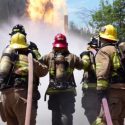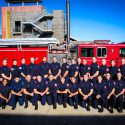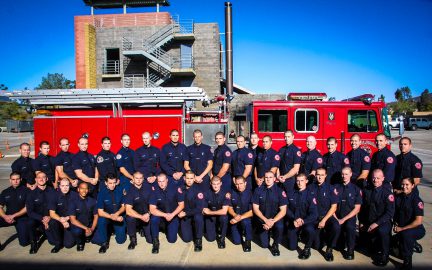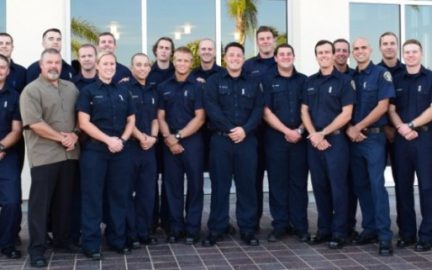
Emergency Management is a fantastically diverse career-field with a favorably projected future job growth. There are a variety of opportunities in public service at all levels of government and in a variety of sectors, including education, healthcare and private business.
-
- Emergency Manager for Cities, Counties, States and the Federal Government
- Disaster Recover Worker
- Fire Prevention Officer
- Emergency Dispatcher
- Emergency Medical Technician Basic and Paramedic
- Firefighter, both Municipal and Wildland
- Homeland Security
- Safety and Risk Manager
An emergency management associates degree teaches students about public safety issues, human behavior in times of crisis, cultural considerations in an emergency and the role of government agencies in disasters. Students gain skills in hazard identification and assessment, emergency management systems, and disaster preparedness. Graduates learn to effectively manage emergencies at every stage, including mitigation, preparedness, response, and recovery. The student will be able to define the role of the emergency manager in preparing for the mitigating the effects of hazards in the community.
This knowledge is identified in the following program courses: Fire Protection Organization, Hazardous Materials, Building Construction, Introduction to Emergency Management, Disaster Response and Recovery, Disaster Mitigation, and Ethics.
Resources and Info
Associates Degree in Science (AS) / Certificate of Achievement (CA)
To earn a Certificate of Achievement in this program, simply complete program requirement courses and applicable electives listed below. To earn an Associate’s Degree in this program, complete the program requirements and applicable electives below and the Associate Degree General Education requirements found here.| Course | Units | Face-To-Face at ESC | Online | Pre-Req |
|---|---|---|---|---|
| Program Requirements (21 Units) | ||||
| FIRE 100: Fire Protection Organization | 3.0 | Spring 2025 | Spring 2025 | |
| FIRE 115: Hazardous Materials I | 3.0 | Fall 2024, Spring 2025 | ||
| FIRE 120: Building Construction for Fire Protection | 3.0 | Fall 2024, Spring 2025 | ||
| FIRE 131: Introduction to Emergency Management | 3.0 | Fall 2024, Spring 2025 | ||
| FIRE 132: Disaster Response and Recovery | 3.0 | Spring 2025 | Fall 2024 | |
| FIRE 133: Disaster Mitigation | 3.0 | Fall 2024 | Spring 2025 | |
| FIRE 142: Fire Ethics | 3.0 | Fall 2024, Spring 2025 | Fall 2024, Spring 2025 | |
| Electives (Select 12 Units) | ||||
| FIRE 51: Fire Academy Preparation | 3.0 | Fall 2024, Spring 2025 | ||
| FIRE 98: Firefighter Skill Maintenance and Update | 1.5 | Fall 2024, Spring 2025 | Must have completed an accredited Firefighter I Academy or Must have completed an approved internal Fire Department training program that follow State Fire Training 2013 standards for Firefighter I | |
| FIRE 101: Firefighter Safety | 3.0 | Fall 2024, Spring 2025 | Fall 2024, Spring 2025 | |
| FIRE 118: Fire Prevention Technology | 3.0 | Fall 2024, Spring 2025 | ||
| FIRE 130: Fire Protection Equipment and Systems | 3.0 | Fall 2024, Spring 2025 | ||
| FIRE 151: Fire Fighter I Academy | 20.0 | Fall 2024, Spring 2025 | EME 106; Certification as an EMT-I; Admission to the Fire Fighter I Academy program | |
| FIRE 160: Wildland Fire Control I | 3.0 | Fall 2024, Spring 2025 | ||
| FIRE 165: Fundamentals of Fire Protection Chemistry | 3.0 | Fall 2024, Spring 2025 | ||
| FIRE 171A: Company Officer 2A - Human Resource Management for Company Officers | 2.5 | Fall 2024, Spring 2025 | Meet the educational requirements for Fire Fighter II or experience as a career or volunteer firefighter | |
| FIRE 171B: Company Officer 2B - General Administrative Functions for Company Officers | 1.0 | Fall 22024 | Meet education requirements for Fire Fighter II or equivalent | |
| FIRE 171C: Company Officer 2C - Fire Inspections and Investigations for Company Officers | 2.5 | Fall 2024 | Completion of a CA Regionally accredited Fire Academy or a signed statement by the agency's Fire Chief or designee stating the sponsored student has completed all SFT training requirements and sills sheets for Firefighter I or equivalent | |
| FIRE 171D: Company Officer 2D - All Risk | 2.5 | Fall 2024 | Completion of the following: ICS-200.B: Incident Command System for Single Resources and Initial Action Incidents Hazardous Material Incident Commander (as offered by the California Specialized Training Institute) | |
| FIRE 171E: Company Officer 2E - Wildland Incident Operations | 2.5 | Spring 2025 | S-290 Intermediate Fire Behavior (Classroom Delivery Only) | |
| FIRE 172A: Instructor I - Instructional Methodology | 2.5 | Spring 2025 | Recommended Preparation: Introduction to the Incident Command System (IS-100.B) or National Incident Management System (IS-700.A) | |
| FIRE 173: Legal Aspects of Emergency Services | 3.0 | Fall 2024, Spring 2025 | ||
| FIRE 180: Fire Prevention IA | 2.5 | |||
| FIRE 181: Fire Prevention IB | 2.5 | |||
| FIRE 194: Fire Instructor IB | 2.5 | |||
| FIRE 197A: Fire Technology General Topics | 0.5-5.0 | |||
| FIRE 197B: Fire Technology Command Topics | 0.5-5.0 | Fall 2024 | ||
| FIRE 197C: Fire Technology Field Topics | 0.5-5.0 | |||
| Total Units | 33.0 | |||
Image Sources
- Fire Technology: Palomar Community College District | All Rights Reserved




 Training to meet the requirements mandated by the California Office of State Fire Marshal for Certified Fire Fighter I. Covers fire ground procedures, tactics, strategy, safety methods, fire dynamics, equipment usage and deployment, and subject material pertaining to the role of fire fighters within the fire service.
Training to meet the requirements mandated by the California Office of State Fire Marshal for Certified Fire Fighter I. Covers fire ground procedures, tactics, strategy, safety methods, fire dynamics, equipment usage and deployment, and subject material pertaining to the role of fire fighters within the fire service.
 The Paramedic Program prepares the student in the elements of pre-hospital advanced life support. Upon successful completion of the program, the student is eligible to take the State of California EMT-P certification exam, which is the National Registry Emergency Medical Technician-Paramedic Exam.
The Paramedic Program prepares the student in the elements of pre-hospital advanced life support. Upon successful completion of the program, the student is eligible to take the State of California EMT-P certification exam, which is the National Registry Emergency Medical Technician-Paramedic Exam.